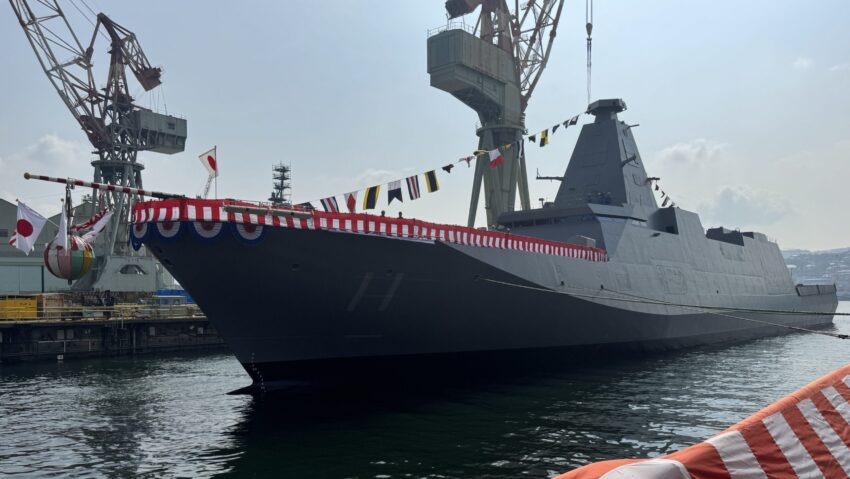The launch ceremony of Japan’s 11th Mogami frigate, made by Mistubishi Heavy Industries. Credit Colin Clark
NAGASAKI — Should Mitsubishi Heavy Industries and its Mogami-class frigate win Australia’s General Purpose Frigate program, the company is prepared to hand over the intellectual property to Canberra, a result of a major push by Japan’s government.
The hope in Tokyo is that the sharing of IP will help secure the Mogami’s win, which would represent Japan’s first major weapons export since World War II, marking a sharp turn from 80 years of strictly defensive weapons development aimed only at the Japanese Self-Defense Force.
The buying of intellectual property is simple in concept — a government buys information, data, patents and the products of a company’s research and development — but has proven to be a thorny issue for most companies in the past. Just look at the recent award of the F-47: The Pentagon insisted the government would own all or most of the intellectual property, in contrast to the F-35 program, where ownership of much of the program’s IP by Lockheed Martin or its subs often slowed the government’s ability to make improvements and increased program costs.
Providing all the Mogami’s IP could be “quite a role model” for how Japan does major military exports going forward, according to Sayako Sumomo, head of Japan’s Acquisition, Technology and Logistics Agency (ATLA). Australia’s National Security Council is expected to make a decision on the next phase of frigate competition, which pits MHI against Germany’s ThyssenKrupp Marine Systems (TKMS) any day now, sources close to the program say.
If Japan succeeds in selling the Mogami, Sumomo said it will help “show how serious the government is, including very high political leaders, like the prime minister, defense minister, foreign minister, the economic minister” about exporting weapons and help Japan create a kind of Foreign Military Sales program.
Sumomo and other Japanese officials spoke last week during three days of briefings on the Mogami program and its proposed sale to Australia. Breaking Defense, like other outlets, accepted travel and accommodations for the trip.
But how likely is Australia to buy the Mogami?
Experts say Australia’s navy and Defense Ministry have two major concerns about the General Purpose Frigate at this point: Whether each company deliver the first three or four ships on time and on-budget, and how much risk does each company face in delivering and integrating its ships into the Australian fleet.
Providing the IP to Australia would be “a significant sign of further movement in Japan’s favor,” notes Euan Graham, an expert on Japan and the Indo-Pacific at the Australian Strategic Policy Institute (ASPI) in Canberra.
Peter Dean, a defense expert at the US Studies Center in Sydney, agreed, saying sharing MHI’s IP with Australia and other measures “goes to show how serious Japan are and how this is a whole of defense (industry & government) effort from Japan.
“They are seeing this as a long-term strategic partnership not just a short-term commercial sale, and that is the best way for them to position themselves to be as competitive as they can be,” Dean wrote in an email
Graham adds that he thinks “‘Speed to capability’ is the most important criterion for SEA3000, and a commitment to deliver ship 1 in 2028 if all stays on schedule would be a major advantage.” That would be welcome news to Japanese officials, who have guaranteed that the Mogami class ships will be delivered on time.
Osamu Nishiwaki, deputy commissioner of ATLA, told reporters during three days of briefings in Tokyo and at MHI’s Nagasaki shipyard that the government has “confidence that Mitsubishi Heavy Industry in Japan already has experience of transferring ship building methodology and technology to other companies.”
“We believe they can transfer that to Western Australian ship shipyards, and in particular their state of the art, digital ship-building technology to Western Australia,” Nishiwaki said.
But Jennifer Parker, a naval expert with the University of New South Wales, argues that the most important criteria for Australia’s decision are not capabilities, sharing IP or production, but how quickly and effectively the winner of the General Purpose Frigate program can be integrated into the Royal Australian Navy.
With Australia’s surface combatant fleet dipping to nine ships next year, she said, “the priority is getting a ship into the fleet as quickly about possible.” She say that while the Mogami is clearly a more capable ship than TKMS’ Meko A-200 (an upgraded version of the RAN’s ANZAC class ships), the fact that Japan has never worked with another country to integrate a weapon into its military could create risks.
Parker says “commonality of equipment, the integration of the supply chain and does it operate similarly to way we currently operate our ships” matters more to the RAN, where she served for more than 20 years. By that measure it might seem that TKMS has a clear advantage since it has provided Meko A-200 ships to Algeria, South Africa and Egypt and has a long history of exporting warships.
But Parker says that the answer to which ship is best positioned to win “isn’t known based on what’s in the public domain.”
Click this link for the original source of this article.
Author: Colin Clark
This content is courtesy of, and owned and copyrighted by, https://breakingdefense.com and its author. This content is made available by use of the public RSS feed offered by the host site and is used for educational purposes only. If you are the author or represent the host site and would like this content removed now and in the future, please contact USSANews.com using the email address in the Contact page found in the website menu.








